Authored by Yimer Hassen*,
Abstract
Easy care finishing of textile materials is one of textile chemical finishing processes to make cellulosic textile materials crease free and dimensionally stable in its service life or during wear. Woven and knitted cellulosic textile fabrics are totally submerged in DMDHEU crosslinking agent with the concentration of 35 – 60 g/l and 30 – 50 g/l for woven and knitted fabrics respectively. In this treatment magnesium chloride is used as catalyst. Then, drying at 110 °C and curing at 150 °C for 3 min. This study shows the relationship between different level of concentrations of DMDHEU and catalysts on different textile properties such as CRA, strength and abrasion loss, washing shrinkage and stiffness. IR analysis also used in the research work. In this finding, in general, crease recovery angle - CRA, abrasion loss, stiffness increases as the concentration of DMDHEU and the catalyst increases whereas air permeability and water capillary rise, washing shrinkage decreases in woven cotton fabric. On the other hand, CRA, abrasion loss and air permeability as the concentration of DMDHEU and the catalyst increases whereas the wales and course washing resistance and water capillary rise diminished in knitted fabric.
Keywords:Crosslinking agent; Pad-dry-cure; Crease recover angle; Washing shrinkage; Strength
Keywords:CRA - Crease Recovery Angle; DMDHEU: Dimethyloldihydroxyethyleneurea; KPa: Kilo Pascal
Introduction
Finishing is generally the last stage of modern textile production. Its goal is to convert the bleached, dyed or printed cellulosic or other fabrics by mechanical and chemical treatment into a suitable state for sale and making-up [1]. Easy care finishing also known as resin finishing, wash-and-wear finishing or durable finishes is the one among different techniques of chemical finishing of textiles. This method of finishing helps cellulosic fibers to maintain a stiff, just ironed or wrinkle free appearance through the lifetime of the article despite various disadvantages such as strength losses, shade changes, reduced whiteness, and controversy about formaldehyde content [2-4].
The primary cause of the shrinkage and crease formation of cellulosic fibers is the fact that these fibers can readily absorb moisture. This absorbed moisture facilitates internal polymer chain movements in the amorphous fiber areas by lubrication. It disrupts the internal hydrogen bonding between these polymer chains. When a moisture laden cellulosic fiber is stressed, the internal polymer chains of the amorphous areas are free to move to relieve that stress. Then, hydrogen bonds can reform between the polymer chains in their shifted positions, in effect, locking in the new configuration. With no restoring forces available, a newly formed shrinkage or crease will remain until additional processes (for example ironing) apply adequate moisture and mechanical forces during to overcome the internal forces. The swelling of cellulosic fibers by moisture can be reduced by the application of self-crosslinking agents and products which reacts with the cellulose molecules [2,3].
Most finishes are applied to fabrics such as woven, knitwear or nonwovens. It is also possible to apply finishing processes to other forms of textile materials, such as fiber, yarn or garment [3].
In recent days, crosslinking agents from very low formaldehyde to zero formaldehyde release have been developing. N,N’- Dimethylol-4,5-dihydroxyethylene urea (DMDHEU), N,N’- Dimethyl- 4,5-dihydroxyethylene urea (DMeDHEU) and 1,2,3,4-Butanetetracarboxylic acid (BTCA) are some of the crosslinking agents used recently.
In this study we have focused to find out optimum concentration of DMDHEU crosslinking agent and magnesium chloride catalyst for high CRA and less washing shrinkage values. In addition, its effect on different other useful textile properties of woven and knitted cotton fabrics has been measured. DMDHEU has excellent durability to laundering, medium to very low formaldehyde release and low chlorine retention effects [2,3,5-7].
Therefore, this study will give us the optimum concentration of DMDHEU and the catalyst on cotton fabric and prevails for further study and comparison of similar application on cotton materials at fiber and yarn stages.
Materials and Methods
Materials
Full bleached and mercerized cotton fabric: Woven fabric (38 end/cm, 30 picks/cm and 130g/m2) and Knitted fabric (14 wales/in, 14 course/in and 230g/m2).
Chemicals: Cross linking agent (Dimethylol-Dihydroxy- Ethylene-Urea- DMDHEU-REAKNITT FF), Catalyst (MgCl2- KATALYSATOR FS), Washing agent and Sodium carbonate.
Methods
In this investigation, cotton woven fabric has been treated with DMDHEU (35 – 60 g/L) and catalyst (15 – 20 g/L) and pre-washed knitted cotton fabric has been treated with DMDHEU (30 – 50g/L) and catalyst (15 – 18 g/L) at different levels.
Fully submerged materials have been passed between the pad rollers at speed of 1 meter per minute. Then the materials have been subjected into 110 °C drying and curing at 150 °C for 3 min using pad-dry-curing method. Both fabrics, initially, have average wet pick-up percentage 87, 9 and 100, respectively.
In this test, nine treated and one untreated sample at five replications each used for investigating crease recovery angle- CRA, washing shrinkage, strength and other useful textile properties. Abrasion resistance tester, Air Permeability tester, washing shrinkage standard ruler, washing laundry, Stiffness measuring inclined plane, weighing balance, TruBurst, IR, water capillary rise, CRA, oven dryer, curing machine and Padder are the machines and instruments were used in treatment and testing of the fabrics. All tests have been collected after dwelling, at least, for 24 hrs. Finally, IR are also used to analyze and decide the optimum concentration of DMDHEU for high CRA and less washing shrinkage properties at minimized effects on other useful textile properties.
Results and Discussion
Bursting strength
Bursting strength is the force that must be exerted perpendicularly to the fabric surface to break off fabric. Strength of the fabric is an important property that decides and influences all other performance properties of the woven or knitted fabrics. Consideration of the strength of the fabric is very essential while selecting the appropriate fabric for the intended garment. Degradation and Loss of elasticity are mainly from the acidic catalysts and stiffness due to self-crosslinking respectively.
We have taken five tests for each sample diagonally to represent all the threads in different parts of the fabric. TruBurst2 instrument was used for measuring the strength of the samples. All the measurement results are in KPa and expressed as percentage strength loss. As shown in Figure 1 and Figure 2, the percentage strength loss increases as the concentration of both crosslinking agent and catalyst increases [3,8].
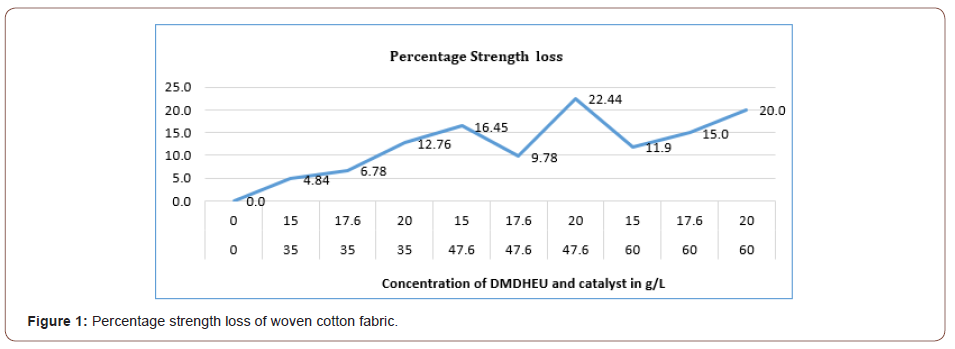
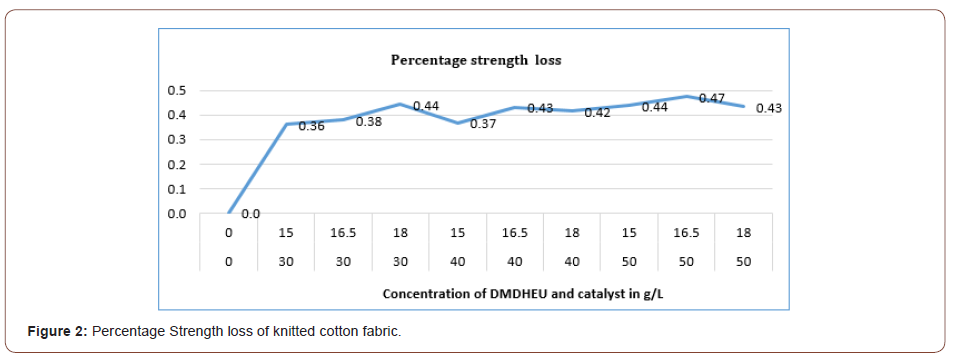
Crease recovery angle- CRA
Crease resistance of fabric is the ability of the fabric to prevent the formation of wrinkles or creases on the surface of the fabric during various uses or process. The crease resistance of the fabric is expressed in the term of crease recovery angle. The total crease recovery angle is the sum of warp and weft crease recovery angles.
Thirty specimens have been measured from both warp and weft way in woven fabric and 20 specimens have been measured for both wales and course way in the knitted fabric. Each sample has 15 mm by 40 mm size. Each sample has been loaded with 1kg for five minutes then takes five more minutes for recovery after unloading. All the results are in nearest degrees. The measurement has been for both faces of the fabrics. As shown in Figure 3 and Figure 4, the total crease recovery angle increases as the concentration of both crosslinking agent and catalyst increases [3,4,7,9,10].
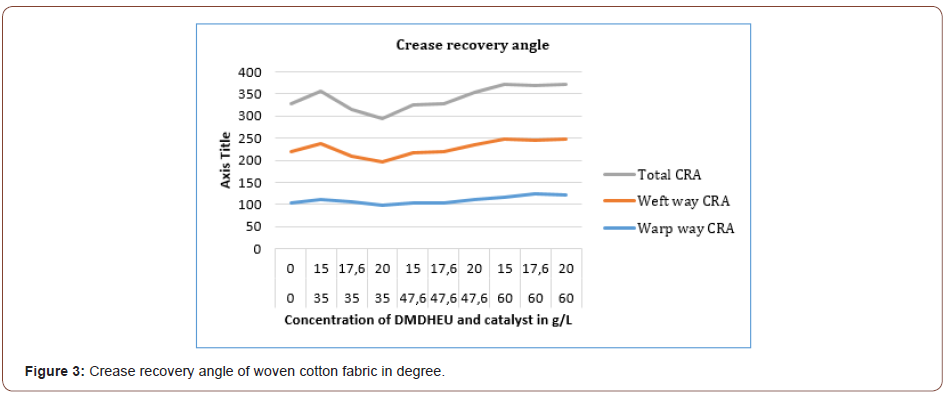
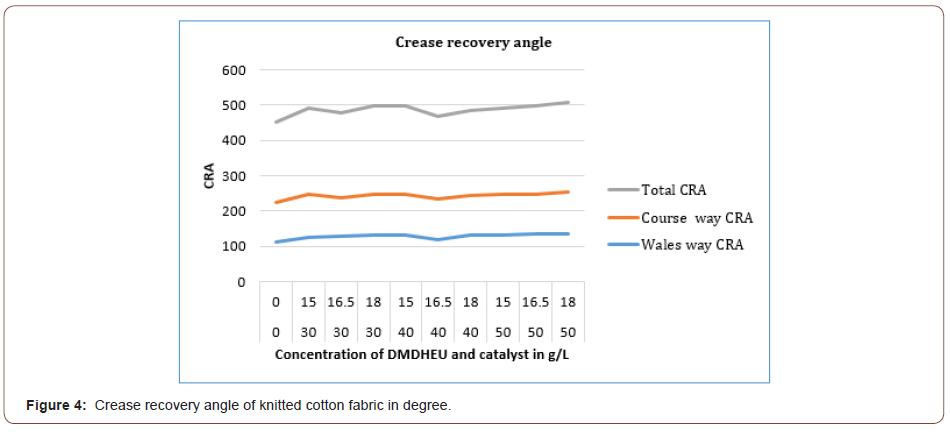
Average flexural rigidity
Flexural rigidity is a measure of stiffness associated with handle. Fabric stiffness and handling is an important decision factor for the end users. The degree of fabric stiffness is related to its properties such as fiber material, yarn, fabric structure and type and method of chemical finish. Three-dimensional crosslinking structure against to the reaction with cellulose determines the level of fabric stiffness properties. 20cm by 4cm specimen size has been taken from both way and face of the woven fabric. Five replications have been taken from each test specimen. Based on the length, mass, width and overhanging length on inclined plane, the flexural rigidity is calculated. As shown in Figure 5, the overall flexural rigidity of woven cotton fabric increases as the concentration of both crosslinking agents increases. However, the flexural rigidity of weft way is greater than the warp way.
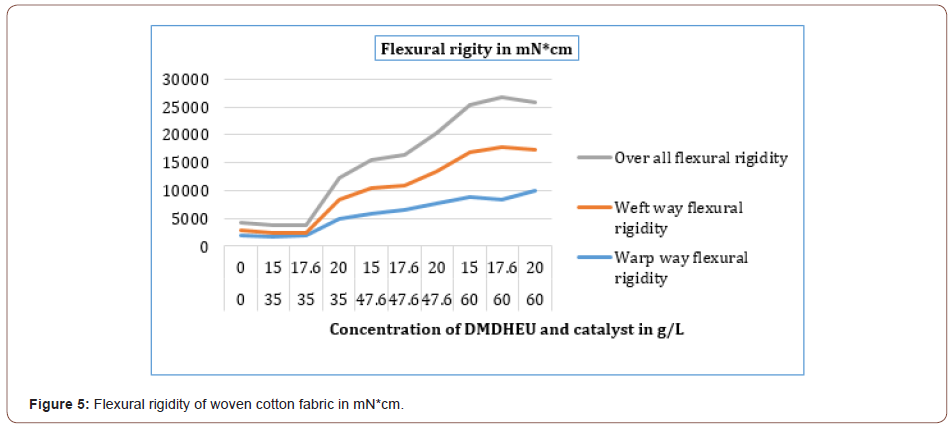
Water capillary rise
Moisture and liquid transport in woven and knitted fabrics are important factor affecting physiological comfort. The kinetic moisture and liquid transport away from the skin surface allows the comfort or discomfort of the wearer. The crosslinking agents are reacting with the functional groups of the cotton fabric. This functional group - OHs are responsible to determine water adsorption into the textile materials. Less -OH groups will have less water adsorption or the reverse.
20cm by 4cm specimen size in five replications for each has been taken. The measurements have been in both directions of the fabrics. The capillary rises are measured in cm. As shown in, Figure 6, water capillary rise reduces as the concentration of both crosslinking agent and catalyst increases.

Washing shrinkage or stretch percentage
Washing shrinkage is used as a factor that determines the change in length and width of the fabric after washing. Shrinkage has great significance because any expansion or shrinkage can cause deformation of the product, which could be a severe concern for the end-user.
In this test, washing agent (40 g) and Sodium carbonate (20 g) have been used for 2 kg of the fabric. In addition, washing was performed under 60 °C for 2 hrs. of washing time. On the other hand, 40g washing agent and 20g sodium carbonate have been used for knitted fabric. The washing has been performed at 40 °C, one hour washing time and under low mechanical washing condition. As shown in Figure 7 and Figure 8, washing shrinkage percentage is reduced in treated material than untreated one in woven cotton fabric. However, weft way washing percentage is greater than warp way washing shrinkage percentage. On the other hand, course way washing stretch percentage and wales way washing shrinkage reduced as the concentration of crosslinking agent and catalyst increased [3,8].
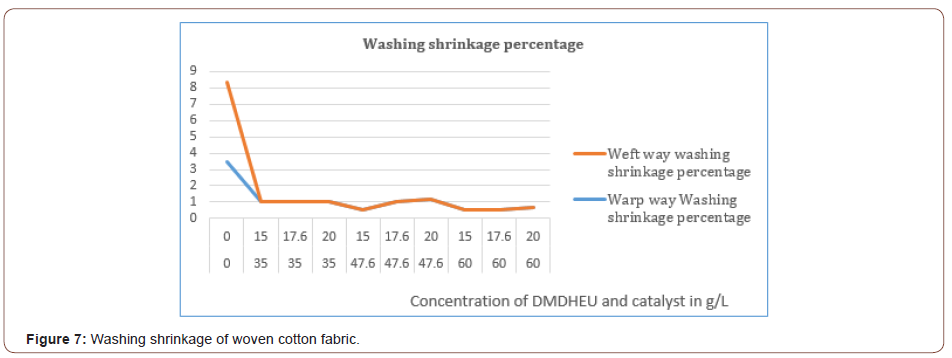
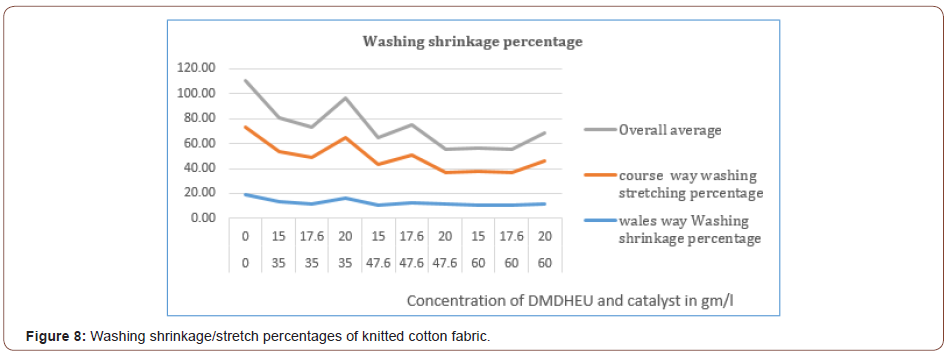
Air permeability
Air permeability is the rate of air flow passing perpendicular through a known area under a prescribed air pressure differential between the two surfaces of a material. It is a measure of how well a fabric allows the passage of air through it. It is assumed to be that the possible formation of 3D structure of crosslinking agent formation than reacting with the cellulosic material will reduce the air permeability properties of cotton fabric.
In this test, we have used air permeability testing machine with a diameter 20cm2 and 100 Pa pressure. The measurements are in mm/s. As shown in Figure 9 and Figure 10, the air permeability of woven fabric reduced at the middle and end of the concentration ranges whereas, the air permeability of knitted fabric is reduced as the concentration of crosslinking agent increased.
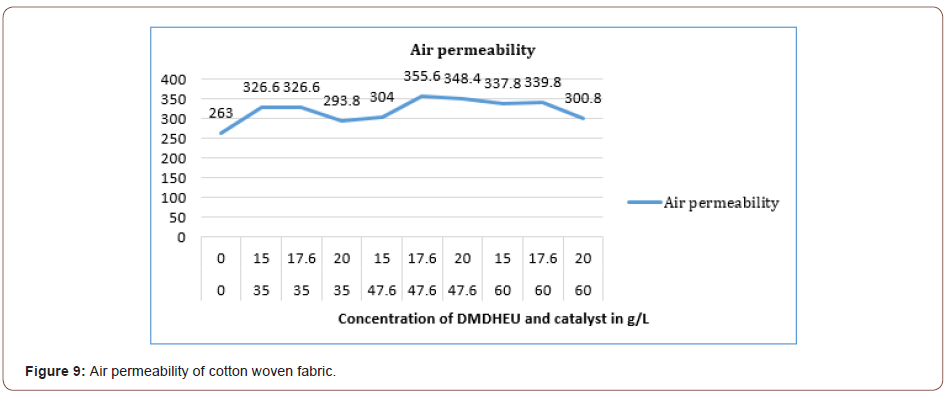
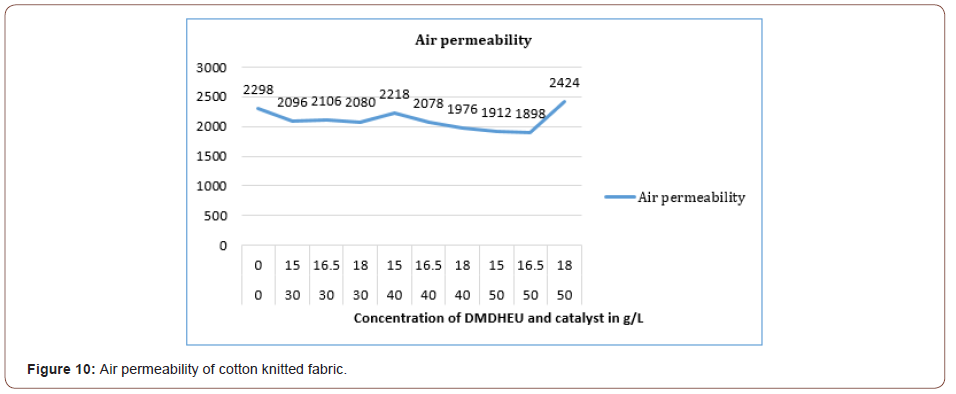
Abrasion resistance
Abrasion resistance is the ability of a fabric to resist surface wear caused by flat rubbing contact with another material. Abrasion is the physical destruction of fibres, yarns, and fabrics, resulting from the rubbing of a textile surface over another surface.
In testing of cotton woven fabric, 11cm by 11cm sample size has been used. The Abrasion instrument has been set to 3000 rpm for 30 s for each testing. The weight differences have been measured for each replication.
On the other hand, in testing of knitted cotton fabric, the machine has been set to 3000 rpm and 20s running time to minimize complete degradation of the knitted fabric. As shown in Figure 11 and Figure 12, the abrasion loss of both woven and knitted fabric increases as the concentration of crosslinking agent and catalyst increases.
Fourier-transform infrared spectroscopy (IR) graphs
Band at 1705 per cm belongs probably to DMDHEU; not present in untreated fabrics and drying at 100 °C/30 min reduces the intensity at 1634 per cm (adsorbed water); 1705 unchanged (Figure 13 and Figure 14).
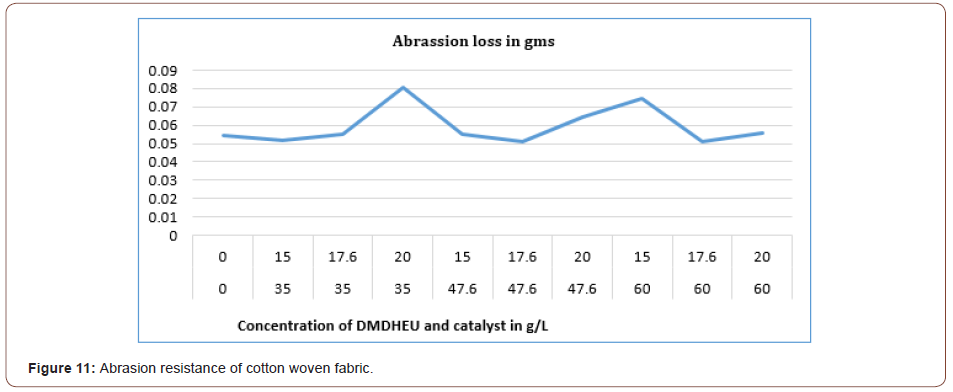
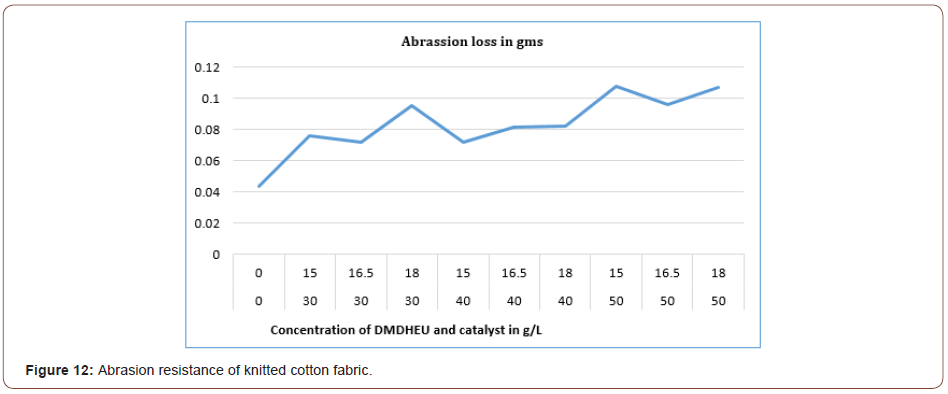
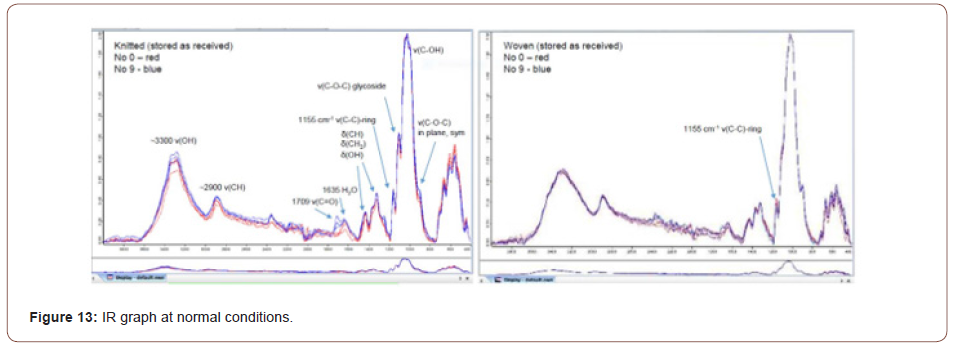
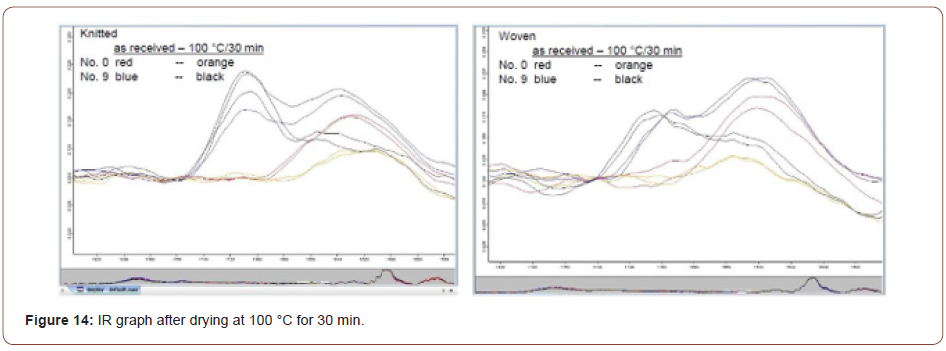
Summary of Woven and knitted cotton fabric properties
Table 1 and Table 2 show the properties of woven and knitted cotton textile materials for respective concentration of DMDHEU crosslinking agent and MgCl2 catalyst.
Table 1:Woven cotton.
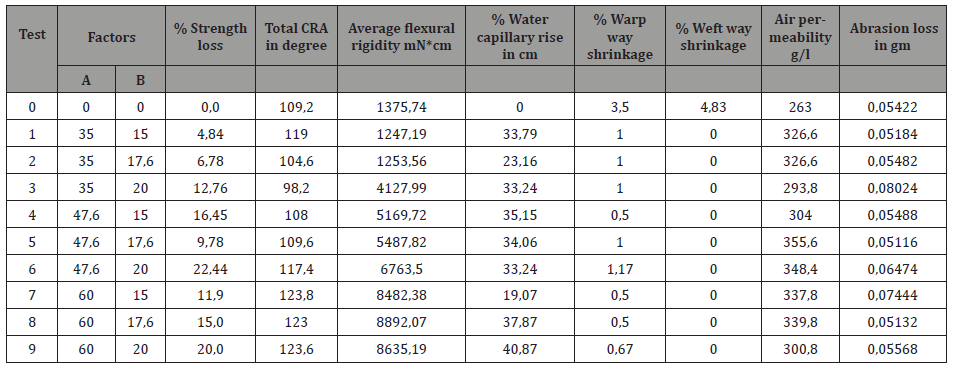
Table 2:Knitted fabric
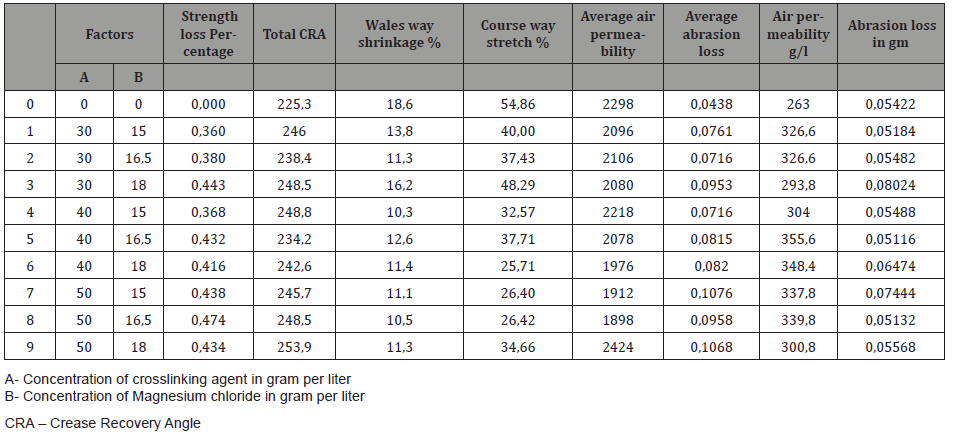
Conclusion
Easy care finishing is one of the textiles finishing process which gives wash and wear or durable press finishes. Among different types of low formaldehyde easy care finishing product - DMDHEU has been used by pad-dry-cure method due to its optimum costs and less formaldehyde release.
Treating cellulose fiber with crosslinking agent produces two possible reactions. These are reaction between cellulose and crosslinking agent or self-crosslinking. It has a great roll in the properties of treated materials. Among different effects of selfcrosslinking it reduces the strength of materials by facilitating the slippage of one molecule over the other in the material.
In general, strength, abrasion resistance and washing shrinkage are reduced and stiffness, total crease recover angle, water capillary rise and air permeability are increased at higher concentrations in woven fabric. In addition, zero Washing shrinkage has seen in weft direction with minimum shrinkage in warp direction. On the other hand, total crease recovery and air permeability are increase, on the other hand strength wales way shrinkage and weft way stretching are reduced at higher concentrations in knitted fabric.
In this investigation, as far as maximum CRA and low washing shrinkage values at minimum fabric damage concerned, the optimum concentrations of crosslinking agent and the catalyst are 60g/l and 15g/l and 50g/l and 16.5g for woven and knitted fabric, respectively with minimum degree of fabric damage.
To read more about this article....Open access Journal of Textile Science & Fashion Technology
Please follow the URL to access more information about this article
To know more about our Journals...Iris Publishers





No comments:
Post a Comment